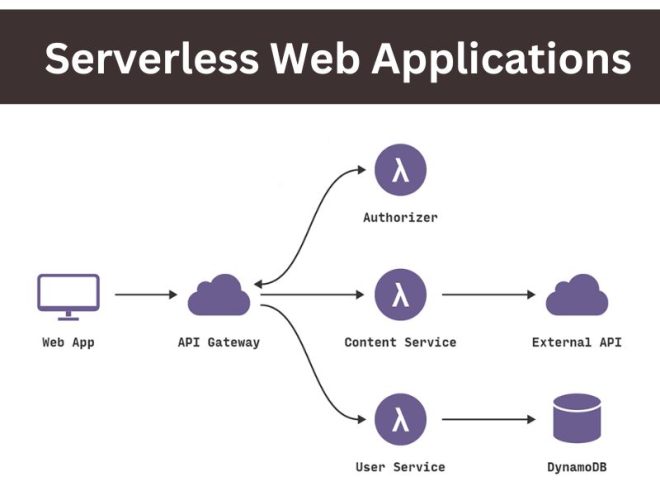Businesses actively pursue efficient and cost-effective solutions to optimize their internet operations in the current rapid digital environment. Serverless web applications revolutionize technology because they deliver deployment simplicity and flexibility along with rare server maintenance requirements.
This guide will explain serverless web applications along with their rising popularity factors and their suitability for being your next project solution.
Fundamentals of Serverless Web Applications
The basics related to serverless web applications need explanation before studying their advantages. The doctrine of serverless exists despite the misconception that servers would not play any role. Without specifying server components the term alludes to server management abstraction where cloud providers handle scalability together with maintenance needs and infrastructure. Developers handle only the tasks of writing and executing code because the cloud service provider handles all remaining functionality.
The main FaaS platforms used by serverless web applications include AWS Lambda together with Azure Functions and Google Cloud Functions. SOAP-based services activate programs to run codes automatically based upon particular events that trigger from system activities or file changes or HTTP requests. Developers avoid underground infrastructure concerns since this design lets them focus exclusively on developing features and functionality.
The following factors constitute the fundamental components of serverless web applications:
- Ephemeral activities are the core building component of FaaS which operates as the backbone of serverless paradigms by performing distinct duties triggered by events.
- Backend-as-a-service (BaaS) provides cloud infrastructure hosting pre-made backend elements such as databases and authentication features and file storage facilities to users.
- API gateways serve to control and route incoming demands towards their corresponding serverless operations.
- Cloud Storage enables the safe management of static resources including documents movies as well as photos.
Motives for the Use of Serverless Web Apps
Several strong benefits are driving the growing popularity of serverless web applications:
- Economy of Cost
Cost effectiveness is among the main advantages of serverless web applications. Conventional online applications need continuous server uptime, which results in continuous maintenance and scalability expenses. Serverless apps, on the other hand, operate on a pay-as-you-go basis, charging you just for the computation time that is actually consumed. This lowers total operating expenses and does away with the cost of idle server capacity.

- The ability to scale
Depending on demand, serverless web applications may scale automatically. Without requiring human involvement, the cloud provider automatically distributes resources to manage traffic surges, regardless of the number of users—ten thousand or ten thousand. Even during periods of high usage, this guarantees excellent performance and dependability.
- Streamlined Development and Implementation
Developers may concentrate entirely on developing code thanks to Serverless Web Applications, which abstract server administration. Launching new features takes a lot less time and effort when deployment is as easy as uploading code to a cloud function. Faster time-to-market and development cycles are made possible by this optimized approach.
- Strengthened Security
For every web application, security is paramount. Strong security procedures, such as automated updates, patching, and threat detection, are used by cloud providers that manage serverless web applications. This lowers the possibility of vulnerabilities and guarantees the security of your application.
- Adaptability and Quickness
Because serverless web applications are so adaptable, developers can utilize a variety of frameworks and programming languages. Serverless functions’ modular design encourages microservices architecture, which makes it possible for various application components to be developed and deployed independently.
- Less Upkeep
Maintaining servers for standard web applications entails routine upgrades, observation, and troubleshooting. By shifting this duty to the cloud provider, serverless web applications enable developers to concentrate on innovation and feature development rather than maintaining the infrastructure.
Serverless Web Application Use Cases
Because of their adaptability, serverless web applications may be used in a variety of situations.
- Web APIs: Serverless functions provide a scalable and economical backend by effectively handling API requests.
- Real-time Data Processing: Serverless is perfect for processing real-time data from analytics, social media feeds, and Internet of Things devices because of its event-driven design.
- Chatbots and Virtual Assistants: Without requiring dedicated servers, serverless solutions allow for rapid and responsive interactions.
- File Upload and Processing: Use serverless features to instantly resize images, compress videos, or convert documents.
- E-commerce Applications: Easily scale order management, payment processing, and user identification.
Serverless Web Applications’ Difficulties
Notwithstanding their many advantages, serverless web applications have certain drawbacks.
- Cold Starts: A cold start is a little lag that occurs during the initial execution of serverless services.
- Vendor Lock-in: Dependence on the ecosystem of a single cloud provider may restrict flexibility and mobility.
- Complex Debugging: Compared to conventional monolithic programs, debugging and monitoring distributed functions might be more difficult.
Conclusion
A strong and effective strategy for contemporary web development is represented by serverless web applications. Businesses may save money and get faster deployment times by outsourcing server administration to cloud providers. Although there are certain issues to take into account, serverless computing is a great option for many use cases since the benefits frequently exceed the disadvantages. Adopting Serverless Web Applications may boost creativity and productivity in your development process, regardless of the size of your project—from a tiny startup application to a massive business platform.
Jobssimply write on education, business, jobs, and even more.



